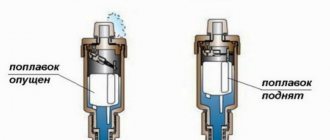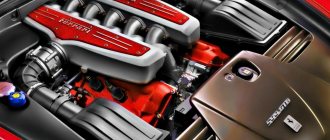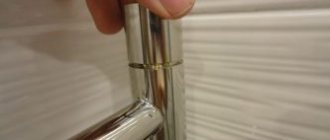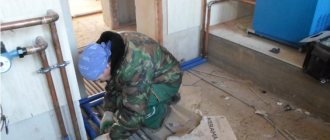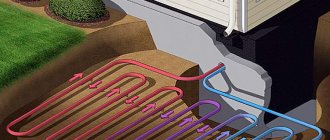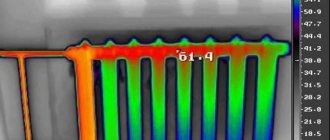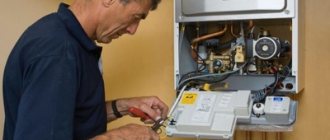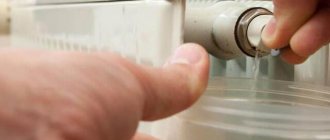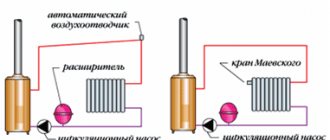The heating system in private cottages and apartment buildings includes pipes and radiator batteries, which are subject to natural airing during operation. Air masses entering the structure form a plug, which complicates or completely stops the movement of coolant in the pipes. The result of this situation is the lack of heating of the air in the rooms to the required temperature levels. There are several ways to bleed air from a heating system. Let's look at the issues of removing air locks
Reasons for airing the system
There are several fairly common reasons that provoke the appearance of an air lock inside heating structures:
- depressurization that occurred during scheduled maintenance or repair work;
- improper flushing or pressure testing of the system followed by filling the water circuit with standard coolant;
- local violation of the integrity of pipelines and radiator batteries under negative external influences or as a result of maintenance and operating errors;
- in private households - the absence of a sufficient pipe slope and expansion tank in the installed system;
- reduced pressure level in the water supply system, filling the resulting voids with air;
- faulty condition of air intake elements;
- connection to the heating structure of a “warm floor” system with pipes of different heights;
- air suction through leaky seam joints and joint areas;
- low quality coolant, oversaturation with gases;
- replenishing the volume of thermal fluid by adding cold tap water.
One of the most common problems is the presence of errors and errors at the stage of creating design documentation or installing pipework.
Why does air appear in the heating system?
Many of our compatriots are familiar with the concept of “air jams”. This phenomenon is remembered at the beginning of the heating season, when heat is allowed into houses, but in apartments on the upper floors the radiators often do not heat up or only heat up in the lower part, and are absolutely cold in the upper part. Where does air come from in pipelines? There can be several reasons for airing:
- carrying out repair work (assembly, disassembly of the pipeline), during which the appearance of air is inevitable;
- non-compliance during installation with the magnitude and direction of the slope of pipelines;
- low pressure in the water supply: the water level drops, and the resulting voids are filled with air;
- when water is heated, bubbles of air contained in it are released and rise to the upper part of the pipeline, creating air jams there;
- the heating system is not filled correctly: after a summer period of inactivity, the pipes should be filled with water not quickly, but slowly, while simultaneously bleeding air from the heating system;
- unsatisfactorily sealed pipeline joints through which coolant leaks. Leaks in these places are hardly noticeable, since the hot water immediately evaporates. It is through loose seams that air is sucked into the system;
- malfunction of air intake devices;
- connecting a water heated floor to a heating system, the pipes of which are located at different heights during installation.
Options for removing air from heating
The optimal way to bleed air would be to install manual (mechanical) or automatic air vents into the heating system. The first (local) option is to install Mayevsky taps at the ends of all radiators.
The second method is the vertical or horizontal installation of high-performance air vents, supplemented with filters for the water supply and return. The maximum efficiency of deaeration is shown by a multi-stage system with separate air discharge at different points.
Mayevsky crane
Needle type shut-off valves STD-7073V are made from different materials. Brass products do not corrode, are reliable and durable. In vertical systems, shut-off valves are mounted on all devices on the upper floor, and in horizontal systems - on all radiator batteries.
Work rules:
- install taps;
- open the shut-off valve one turn;
- close the tap when water appears.
How to bleed air from batteries in a private house
In private homes, a situation may also arise in which air appears in the heating system. What is important is not how the heating system in a private house is aired, but how to get rid of unnecessary air. There is no universal solution to this problem - the heating of a private house is usually designed individually, so the assembled structure has a lot of its own nuances.
However, all types of heating systems have similar features that need to be studied before bleeding air from the battery:
- If the heating has forced circulation, then special air exhaust elements are always installed near the pump (as a rule, they are located either in front of the pump or directly in the boiler). Air in the system in the presence of such elements is most often due to their clogging.
- Air vent valves can also be installed directly on batteries, but only if they are located above the filling point. If the bottling is located somewhere at the upper level, then the air valve should be looked for at its highest point.
- All vertical bends of the filling have their own air vents. If they are absent, you will have to use one of the methods described above to bleed air.
Before you bleed the air from the battery, you need to make sure that the heating system is started correctly - sometimes the reason for its stopping is a valve that is closed in one of the sections.
Draining through expansion tank
In households with an individual heating system, expansion tanks of closed and open type are installed. In open structures, the level of water or other heat carrier naturally drops.
It is advisable to top up the system through the lower radiator valve, but it is possible to pour coolant directly into the tank. The running system should be allowed to run for several minutes, which will allow the plug to be pushed out. Otherwise, a standard drain through the radiator is used.
Diagnostics of heating circuits for air pockets.
The presence of a blockage in the heating system is usually identified when analyzing the possible reasons for the insufficient efficiency of home heating. Airy radiators can be diagnosed by feeling - cold areas will indicate the presence of air. Inspecting the pipeline is also simple if it is not equipped with thermal insulation or decorative elements, otherwise all casings must be removed.
Tapping the system in this case is not very effective - it will not show a clear boundary between air and water, and the tone of the tap depends not only on the contents of the pipe, but also on other factors - the length of the span, the thickness of the wall in a given place, etc.
Having determined the location of the air in the system, they decide how exactly to bleed air from the heating pipes.
Bleeding the pump
If the heating circuit has a built-in circulation pump, then an air lock, as a rule, disrupts its functioning. When installing pumping equipment above the comb, or using only a standard unit (heating boiler), you need to loosen the screw located in the central part of the cover. As a result, all the accumulated air will come out. After bleeding the air, the circulation pump must be turned on for 5-10 minutes to pump the pipeline network.
Why does the heating system get airy?
- Most often, when traffic jams occur, it turns out that a small leak has formed somewhere. It may not be visible to the naked eye, because a small amount of water may have time to dry on the surface of the pipe. A more effective way to detect leaks is to inspect the system with a thermal imager.
- Air inevitably enters during the filling stage with coolant. After the system has been filled, it is important to bleed the air several times.
- Traffic jams could have occurred during repair work.
- Even if the system has not been repaired, over time oxygen is released from the water, which accumulates in the upper points of the pipeline.
- A leak can occur where it is least expected - in air vents; modern automatic models operating in low-quality coolant are especially susceptible to this.
Do you know why an air vent is needed in a heating system? Air valve for heating - read all about this device in the article.
Tips for choosing bimetallic heating radiators can be found here.
A wall-mounted radiator is an excellent option for heating a room if there is no centralized heating. In this topic you will find useful recommendations for choosing an electric heater.
Signs of air in heating
Improper functioning and decreased efficiency of the heating system due to its airiness is accompanied by characteristic symptoms:
- too noisy movement of coolant through pipes and radiators;
- vibration of structures, weakening of connections and destruction of welds;
- violation of coolant circulation;
- uneven heating of the battery in different parts;
- a noticeable increase in the consumption of fuel resources.
Air masses accumulated inside metal structures provoke gradual corrosive changes, which causes the destruction of the system and its premature failure. It is necessary to get rid of air jams as soon as possible.
Signs and consequences of an airy system
If the boiler unit is working properly, the supply temperature of the coolant is normal, but the battery cannot cope with heating the room, check the presence of air in the heating system. Air pockets in radiators are a common occurrence; their presence is indicated by uneven heating of the device when the upper part remains cold. Airiness of the battery at first slightly reduces its heat transfer, but if the problem is not solved in time, the accumulated gas will block the path of the coolant and the room will not receive full heating.
Air bubbles interfere with the free movement of the coolant due to the narrowing of the channel, and this provokes the appearance of specific sound effects. Signs of a traffic jam include noise in the pipes, bubbling, and seething. In difficult cases, pipe vibration is also added.
Airing the heating system
Small air bubbles that have not yet formed a plug, but are already actively released from the coolant, turn it into a water-air mixture. It is dangerous for a circulation pump that is not equipped to pump gas. Sliding bearings are installed on the shaft of the pump unit, which must be located in a liquid medium. High air content in the coolant leads to premature wear of elements due to the effect of dry friction.
If you do not bleed air from the heating system, its excess in the coolant can lead to stoppage or breakdown of the circulation pump
. This is dangerous for solid fuel boilers that are not equipped with automation: when the circulation stops, cooled coolant will no longer flow into the water jacket of the boiler. Overheating and boiling of liquid in a confined space threatens to explode if the safety group does not work.
Knowing how to remove air from a heating system, you can deal with air lenses in radiators made from materials prone to corrosion and overgrowth. The air contains carbon dioxide and oxygen, and they contribute to the breakdown of calcium and magnesium salts that are dissolved in water. The reaction proceeds with the release of carbon dioxide. Under the influence of high temperatures, hydrocarbonate compounds form a layer of limescale, and carbon dioxide promotes corrosion of metal surfaces. As a result, the battery deteriorates faster.
Accumulated dirt in the heating system contributes to radiator failure
To avoid unpleasant consequences when starting the heating system at home after the summer break, you should check it for air pockets. If it is airy, quickly take measures to eliminate the problem.
Preventive measures
The most effective and accessible preventive measures aimed at preventing network airing include:
- compliance with the installation rules of all structural elements and components;
- installation of special devices that remove air manually or automatically;
- regular inspection of the tightness of joints and connection areas;
- bleeding air until the heating system is filled with water;
- monitoring the operation of water heating equipment;
- checking the characteristics of the thermal fluid for compliance with the requirements;
- monitoring of pressure gauge readings and pressure in pipelines;
- systematic visual inspection of pipelines and radiator batteries.
It is strongly recommended that during operation and maintenance periodically perform routine removal of air pockets.
How to bleed air from a heating system
Bleeding air from a heating system is not so easy. You need to know in what order to act, where to open what, where to close. And the order of actions depends on the composition of the system.
If air vents are provided, removing air from the heating system will not be too difficult
When filling
When filling the system (first start-up, repair or change of coolant), there will definitely be air pockets. Therefore, before starting the boiler, they must be removed. This is done on a cold boiler, that is, the coolant must be cold. They operate in this order:
- Fill the system to the required pressure (check with a pressure gauge).
- Bleed air in all radiators by opening Mayevsky taps or checking the operation of automatic ones. You need to go around all the radiators several times until water flows out of the valves without bubbles. If there are automatic drain valves somewhere, check whether they work or not, whether they release gases during pumping or not.
- Air bleed valves are installed on each radiator
- Run the system several times.
- Go through all the radiators again.
- Repeat as many times as possible until, after the next run, coolant immediately flows out of all radiators.
If the pressure in the system is normal, you can start the boiler. If the pressure is lower than required, add coolant and repeat everything again. Please note that it is prohibited to bleed air on the membrane expansion tank. This is not air from the system, but a specially inflated reservoir to maintain stable pressure in the system.
If there are high points in the system (for example, bypassing a door from above), a bleed valve should be installed at any such point to relieve air. If you can still install a mechanical tap on radiators, then automatic models are definitely better at these points. But keep in mind that for stable operation it is better to take more expensive models. They break down less often, so you end up spending less money.
To make it easier to bleed air from the heating system, air vents - manual or automatic - are installed at all possible points where air pockets form.
Air exhaust devices should also be installed at pipeline turns. These are also points where bubbles accumulate, and the presence of automatic valves here to remove air will make life much easier - you will have to worry less about air jams, since most of it will be removed automatically.
In systems with water heated floors
With a combined heating system - heated floors + radiators - you can try to expel air through the radiators. The process is described above. If the air has been released 5-6 times, and some circuits are still cold, you will have to “drive” each of them one by one. The process of removing air from a water heated floor is as follows:
- When the boiler is stopped (standby mode), close all valves on the supply manifold.
- We open the supply of the first circuit, turn on the boiler and leave it to work for several minutes. Using the valve, we release the air. At the same time, it leaves the boiler through the built-in automatic air vent.
- We drive it again and lower it. So until the coolant flows without bubbles.
- We stop the boiler, close the supply of the first circuit, open the supply of the second.
- Turn on the boiler.
- Let's deflate.
We run each circuit this way, not forgetting to stop the boiler. If the boiler is not turned off, two situations may occur. The first is that all circuits will be closed, which can lead to a rupture in a “weak” place. The second is that two circuits will be open and air from the “unpumped” one can get into the “pumped” one, so that all the work done previously will go down the drain. Therefore, we try not to stray from the algorithm and stop the boiler before closing/opening the next circuits.
In heating systems with warm water floors, it is more difficult to remove air: the circuits are long. To remove air from the system, it is necessary to run each circuit one by one.
Now you know how to bleed air from a heating system with heated floors.
Branched radiator system
Typically, in heating systems of cottages on two or more floors, air pockets appear in the radiators of the upper floors. However, simply blowing air on them a couple of times does not always help. It accumulates again and again. Let's look at the correct sequence of actions.
The presence of automatic devices for removing air from the heating system will make life easier: getting rid of air jams occurs on its own
If the heating system has several “branches”, you need to proceed approximately according to the same scheme as described with the underfloor heating manifold: alternately squeeze out the air in each of the branches. It is necessary to close all the “branches” except one, pumping coolant through it to bleed air (through air vents on heating radiators and other devices). In the same way, stop the boiler, close the tap on the “waste” part of the system, and open the other. In theory, in houses on several levels it is better to move from bottom to top, first bleeding air from the radiators of the base floor (if any), then the first, second, etc.
How to prevent air from entering the system?
When installing heating, during the seasonal start-up of the system and repairs, it is extremely difficult to completely avoid air ingress. During operation, you need to know that air is released from the new water. A month or two passes, and there is no oxygen left in the liquid.
However, in order for the coolant to be used for a long time, it must remain of acceptable quality, as well as the inner surface of the pipes.
Plastic pipes do not clog the water with scale.
Antifreeze is also free of these disadvantages (however, its viscosity changes over time).
Well, the weakest link in terms of the source of pollution is the boiler heat exchanger. It is subject to sudden changes in temperature.
When purchasing a boiler, it is important to pay attention to the material of its water jacket or coil.
Filling the system with water
- To begin with, we open all the taps (on both sides of the pump, on all radiators, on the water floor collectors, on the expander), and close the Mayevsky taps.
- The system must be filled from the bottom up. The inlet hole is made in the very bottom part (the coolant is drained and filled through it).
- The main valve opens at the top (at the highest point of the system) to release air and slowly fill. There is no need to rush, just so that the air has time to escape. The liquid supply remains open until water flows from the valve.
- The system accumulates the pressure recommended for it as working pressure. Then, one by one, the air is bleed from each radiator in the house (it’s time to close the tap when the water starts to trickle).
- There is a screw in the central part of the circulation pump that can be loosened using a screwdriver. The air is bled from the pump, then screwed on.
- After the air is released, the pressure in the system will drop and the water supply will need to be turned on again to make up for the losses.
- After this, a test run of the boiler is made at a low temperature (about 40 ° C), with the pump turned on. During this start-up, it is recommended to go around and inspect all elements of the system - are there any leaks, is air escaping somewhere, are all radiators heating up evenly. Then, you may need to add water again and then start the boiler in operating mode.
Filling the system with water
If suddenly one of the taps remains closed, and the system is already filled and the pressure is high, you need to open the valve very slowly and carefully. Otherwise, you will get a decent water hammer.
Where should air vents be installed?
The installation principle is vertical, not horizontal. In order to remove the annoying air lock without any problems, it is necessary, first of all, that the installed air vents be installed in the right places. Namely:
- at the highest point of the highway
- in collector heating - on each ridge
- in case of triple wiring - in front of each branching node of the system. But after installation, you need to set the correct pressure value at which the counter will operate. When getting rid of an air lock in an autonomous heating system, first reduce the temperature of the coolant to a minimum value, which will lead to a decrease in the volume of water and this will help to effectively eliminate the problem.
Also automatic.
